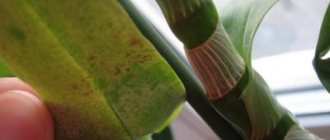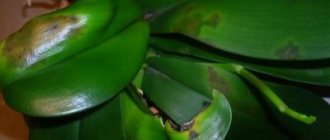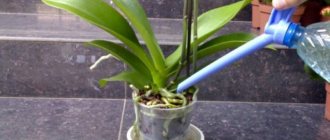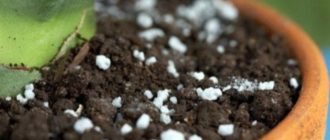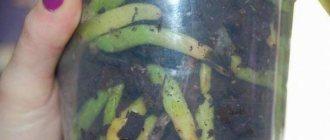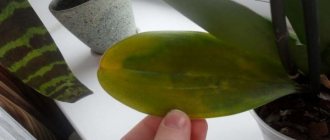Main diseases of orchids
Usually lesions occur due to improper care of the flower. This can be easily corrected by changing your care regimen. But sometimes they indicate the presence of an infection that needs to be dealt with urgently. The appearance of diseases can most often be determined by the leaves (unnatural color, destruction, etc.). But other parts may also be affected.
Fungus
Fungal infections occur if the orchid is placed in a room with an unacceptable temperature or suffers from too much humidity.
Wet leaves are excellent soil for fungal development. Its danger cannot be underestimated. A sick orchid can die within a few days, or even infect other plants.
The fungus is recognized by black rot on the leaves. They look like an ordinary dark spot. Most often it occurs due to improper watering or when the room is cold.
Darkened sheets must be removed: cut them with clean scissors to the green tissue. Rinse the cuts and spray with fungicides (general action or specializing on anthracnose) with water. If the lesion is small, you can leave nothing at all and just spray it with chemicals for a few days. The orchid must be isolated from other flowers and kept dry for some time so as not to provoke the development of infection.
Important! When using chemicals, make sure that the orchid is included in the list of plants they treat. Be careful when spraying. Don't forget about gloves and special clothing.
For prevention, you need to maintain a moisture balance. During cold seasons, water less often. In summer and spring, if watering is abundant and regular, provide enough light and fertilizer.
Other precautions:
- cleanliness - remove fallen leaves immediately and do not forget to clean the plant itself from dust;
- ventilation - so that roots and leaves dry out faster, especially important in warm seasons;
- spraying - once or twice every three months you can spray the orchid with fungicides, this is an excellent prevention against parasites.
It is not so difficult to defeat the fungus, and the likelihood of its occurrence decreases significantly if you follow these simple rules.
Viruses
Viral infections rarely affect orchids. But, if this happens, in this case, unfortunately, the plant cannot be saved. It must be destroyed immediately so as not to infect others.
You can recognize the presence of viruses by yellow and brown spots on the leaves.
The disease progresses as follows:
- Starts with small light yellow dots.
- Gradually the spots become larger and darker.
- Small swellings appear.
- Over time, the spots are pressed in and the leaves are “eaten away.”
Symptoms vary from virus to virus, so an accurate diagnosis can only be determined in a laboratory.
It is possible to leave a plant infected with viruses alive only if they manifest themselves this way only in “stressful” situations. For example, only at a certain temperature. But then the orchid must be isolated, cared for more carefully, and instruments must be disinfected after use.
Bacterial diseases
The most common diseases among the orchid family. They occur when bacteria enter the plant and cause pus. Therefore, this infection can be recognized by different types of rot:
- brown;
- black;
- root;
- fusarium.
Not only leaves are affected, but also roots and stems. Indentations or pseudobulbs may appear. The plant emits an unpleasant odor, and rotting spots are sometimes wet.
Treatment should be started immediately. Isolate the orchid. Cut off the affected leaves with sterile scissors and disinfect the cut. For prevention, reduce watering, keep the flower at a temperature of 20–23°C, and avoid exposure to bright sunlight. If treatment is timely, it will be effective. Otherwise, the plant will die.
Gray rot
Gray mold is a fungal infection. Occurs when there is high humidity, or due to a sharp temperature change. Another reason is that the fertilizers used contain too much nitrogen.
First of all, the disease affects the dried parts of the flower, then spreads to healthy tissue. Appears in the form of watery spots with light gray inclusions. This coating is easily erased and resembles dust. As the disease progresses, the spots become increasingly gray. Then they acquire a slight “fluffiness”.
Treatment consists of several stages:
- The infection is transmitted through the air, so isolation first.
- Remove infected leaves and areas.
- To combat it, you need to improve care measures: reduce humidity and the number of waterings, provide ventilation, and sunlight.
- If the lesion is large, treat with fungicides.
Important! Orchids quickly adapt to chemicals, so the preparations need to be changed with each treatment.
For prevention, you can use products that increase disease resistance in orchids.
Rust
Rarely found in the orchid family. Rust is also a fungal species. Infection can only be caused by regular mistakes in care that reduce the plant’s immunity.
Spots of orange and yellow shades appear on the leaves. Inside are microscopic black dots. Growths and compactions appear on the reverse side of the leaves. Over time, they burst and the blackheads (fungal spores) are released.
The following can cope with the disease: fungicides, or soda, iodine (for small lesions). Stages of the fight:
- The plant must be washed thoroughly with warm water, rid of spores and remove “bubbles”.
- Wipe and let dry.
- Cut off diseased areas, sprinkle the incision areas with activated carbon.
- Place the orchid roots in a preparation diluted with water. Leave for 10 minutes.
- Remove the flower, place on a napkin and dry.
After the main treatment, you need to carefully take care of the flower for several months.
Anthracnose
This infectious disease can easily be confused with sunburn. The difference is as follows: with anthracnose, the spots have a yellow edge. And, most importantly, over time they grow and affect the entire leaf, while burns rarely change.
Treatment should begin with isolating and removing the lesions (it is better to cut off both the affected areas and 1-2 cm of apparently healthy tissue). Disinfect the incisions. This can help:
- iodine;
- soda;
- Activated carbon;
- fungicides.
The disease is aggressive, but in the initial stages it is easy to overcome. You should not allow damage to many areas - the more leaves are cut off, the more difficult it is for the flower to recover.
Growth point
The growing point is the top of the trunk from which the leaves grow. If it begins to rot, the orchid no longer grows and begins to die. Therefore, it is important to ensure that such points are healthy.
For different injuries, different measures are necessary:
- mechanical damage - scratches, breaks, burns, etc. If the end of the stem is damaged, the leaves will no longer grow, but later another bud will appear;
- rotting - possibly due to excess moisture. You need to remove the leaf and treat it with activated carbon or cinnamon. If the rotting is large, cut to living tissue and treat with alcohol;
- exposure to pests - mites, aphids, thrips, etc. To begin, destroy the pests, remove the affected area with a reserve, treat the cut with iodine or brilliant green, and then with fungicides.
As a preventive measure, simply avoid excess moisture and direct sunlight on the growing points.
spotting
Spots may indicate disease. Depending on their appearance, the source can be assumed.
- ring-shaped - viral, fungal infections;
- yellow, dented and lightened over time - Phalaenopsis virus;
- black, depressed - Fusarium wilt;
- yellow at first, turning black over time - phyllosticosis;
- wet with a light rim, then darken - septoria;
- light, then darken, with small rings inside - Alternaria;
- black, depressed with light inside - possibly sunburn.
The specific diagnosis can be determined in the laboratory.
Bacterial diseases of orchids
Compared to fungal diseases of orchids, they are quite rare. The reason is the penetration of bacteria through damaged tissues of a weakened plant.
Bacterial soft, brown rot
Symptoms. Small water-soaked spots appear on the leaves, often surrounded by yellow halos. On phalaenopsis, the disease spreads so quickly that the plants can completely rot in 2-3 days.
Bacterial soft rot of phalaenopsis leaves
The leaves appear yellow and saturated with water, then darken and fall off.
Root soft rot of bacterial origin quickly spreads to the pseudobulb, neck and other parts of the orchid, causing decomposition not only of the roots, as with a fungal infection, but also of all parts of the plant. This process is often accompanied by an unpleasant odor.
Bacterial spot
It is the most common and severe disease of phalaenopsis orchids. Symptoms can appear anywhere on the leaf as a small, soft, water-soaked spot that may be surrounded by a pale green or yellowish halo.
Bacterial spot of phalaenopsis
Initially dirty green in color, the infected spot enlarges over time and turns brown, dries out and turns black.
Disease progression
The main difference from fungal spots is the formation of a kind of oily halo around them. In addition, bacterial spotting spreads much faster.
On cattleyas, the infection usually affects older leaves, producing black spots that are clearly demarcated. Progresses slowly and rarely ends in the death of the plant.
Treatment for bacterial diseases. Immediately remove the infected tissue using a sterile instrument, spray bactericidal preparations, such as physan or those containing copper compounds, on the infected and neighboring plants.
Extensive phalaenopsis infestation that cannot be treated
You can try using some synthetic antibiotic, for example, tetracycline. Hydrogen peroxide is used as a home remedy.
Hot and humid conditions favor the development of the disease. Periodic preventive spraying with copper compounds helps prevent infection, especially in hot and humid weather.
It should be noted that in practice there are quite a few successful cases of healing orchids from bacteriosis; a positive result is not guaranteed. If you cannot determine the causative agent of the disease (whether it is a fungus or bacteria), use an antibiotic along with a fungicide.
Damage to plant parts with photos
As a rule, plant disease is reflected in the leaves. But sometimes it moves to other parts. For example, drops on the stem indicate improper care, and gray rot begins with flowers. It also depends on the source of the disease. When examining an orchid, it is important to examine the entire plant.
Leaves
The nature of the leaf disease can be infectious or non-infectious. The former are always associated with improper care: temperature changes, frequent watering, etc. The latter are associated with the penetration of viruses, fungi, and bacteria onto the flower.
Types of non-infectious lesions are associated with:
- improper watering (without or with damage to the root collar): swelling;
- thermal disorders: thermal and sunburn, frostbite;
- mechanical damage: cuts, scratches.
Infectious lesions:
- fungus: fusarium, gray rot, anthracosis, black rot, phyllostictosis;
- bacterial: soft rot, bacterial spot;
- viral.
As a preventative measure, avoid over-humidification, maintain a stable temperature, and provide ventilation.
Roots
The roots may begin to rot or dry out. The reasons are divided into three groups:
- viral: the plant is completely affected, the roots are covered with small spots and stripes;
- fungal: a coating of a certain color appears on the roots (usually yellow, brown);
- bacterial: ulcers appear that look like blisters with fluid inside.
If the root turns black and breaks, the orchid is dead. Drying indicates a lack of water, rotting indicates waterlogging.
Peduncle
In case of disease, the same symptoms apply to the peduncle as to the leaves and stems. But there is also an independent symptom - the appearance of sticky drops. This is the sap of the plant. Outwardly it is transparent, easy to confuse with water. Juice sometimes indicates improper conditions, most often waterlogging. If no action is taken, the orchid will weaken, and fungus may develop or pests may appear.
Flowers
Flowers are affected in the same way as other parts of the plant, but have several distinctive features. As a rule, when gray rot occurs, they are the first to suffer. A gray coating on them is the first sign of the disease. The number of flowers also indicates health. If there are few of them, they look lethargic or weak, or have spots or dots, the orchid is not fine. Conversely, luxuriantly blooming flowers are evidence of a healthy plant.
Stems
The stem may dry out, turn yellow, or rot. The main diseases appear on it in the same way as on the leaves. The most common complaint is yellowing.
The reason for the unnatural color may be:
- sunburn;
- lack or excess of moisture;
- lack of light;
- infections, fungus, etc.
Do not confuse painful yellowing with natural yellowing. Healthy color change occurs within five years after purchase and is associated with the death of old leaves.
How to deal with drought?
Before treating a plant for drought, it must be carefully examined. If there are rotten places, they need to be cut off, rubbed with coal or treated with an antiseptic.
- If the leaves turn yellow, wilt and begin to dry out, then you need to pay attention to the root system. Have the roots changed color and become thinner? This means that a drying orchid must be moved to a cooler space, watered and sprayed, cared for for several days, and monitored at the temperature to avoid overheating.
- If the leaves are limp, the plant has dried out and the roots have begun to rot, overwatering is possible. It is necessary to reduce watering of the plant and ensure that the soil is dry. If it becomes crumbly on top, you can water the plant again.
- If the roots have dried out and the plant has lost some leaves, this is a lack of watering. We need to restore the water balance. If condensation remains on the walls of the pot, water it early (watch for 7-10 days).
- An orchid can dry out from the wrong selection of fertilizers, namely, their excessive use.
If there is an overdose of nitrogen-phosphorus-potassium fertilizers, the orchid withers. To cure a plant, you need to change the substrate and strictly follow the fertilizer instructions. Most often, with symptoms of drought, the flower can be saved. The main thing is to start rehabilitation on time.
How and with what to treat a flower at home?
You need to be careful with home treatment. Before using drugs, isolate the plant and make sure there are no children nearby. Spray only in special clothing. And select a fungicide whose list of approved plants includes phalaenopsis.
Use of chemicals
Fungicides, iodine, and activated carbon are suitable for treatment.
Chemical preparations can be general or specialized. Before use, you need to find out the diagnosis, then look for medications.
There are many means to control pests:
- "Fitoferm";
- "Aktellik";
- "Tiofos";
- "Neoron".
The frequency and interval between sprayers should be checked with a specialist.
Important! Orchids easily develop immunity to insecticides, so they need to be changed frequently.
Iodine or crushed activated carbon is usually used to treat the incisions left after removing the affected areas. Iodine should be diluted with a small amount of water, applied to the incision and left to dry. And you just need to sprinkle activated carbon on the desired area.
Folk remedies
Traditional pest control solutions:
- soap solution, apply it to the entire above-ground part of the orchid;
- olive oil with warm water;
- garlic solution.
Dense leaves can be wiped with ethyl alcohol, flowers and peduncles can be rubbed with garlic or onion. There is also a popular folk spray that can be obtained by boiling cyclamen roots in water for forty minutes.
Also, if there are no chemicals at hand, some gardeners treat the cuts with cinnamon or soda.
Why does orchid rot?
Putrefactive processes in any part of the plant are mainly associated with increased and prolonged humidity at low ambient temperatures . This is especially true for inexperienced flower growers.
Having no experience, not knowing the physiological characteristics of tropical orchids, they care for their pets too hard, not realizing that they are only harming the plant.
Causes
The main reasons why an orchid rots when grown at home are:
- excessive watering;
- poor quality soil;
- Greenhouse effect;
- sunburn;
- hypothermia;
- organic fertilizers;
- excess fertilizer;
- weakened plant;
- pests
Often the cause of rotting is excessive watering.
Which plant organs are under attack?
The most vulnerable part to putrefactive processes is the root system . Overwatering causes the soil to become compacted and decompose, and in the absence of good ventilation, rapidly spreading pockets of rot are formed.
Second place belongs to the leaves of the plant . Damage by direct rays of the sun or pests opens the flow of air into the intercellular tissues, where the process of decay begins.
The third place belongs to the pith or stem . Inaccurate watering, irrigation or pests quickly lead this part to the center of the spread of the fungus.
How to cure plaque on leaves?
Plaque can occur due to:
- gray rot;
- mosses and algae;
- whitefly infestation;
- rust;
- mealy worm.
Treatment varies depending on the cause. If the problem is a fungal infection (gray rot, rust, etc.), use fungicides. And if a white coating appears, then the problem is pests, and only an insecticide will help.
What does an infection look like?
The question of what powdery mildew looks like on orchids is often discussed on orchid growers forums. This is due to the fact that at first glance it may seem like a harmless light spot on the sheet. If you wipe it, it will disappear. There is a deceptive feeling that the problem has been solved.
However, with a fungal infection, the spots will soon reappear in the same place or nearby. They are a dense coating of grayish-white color. This is the mycelium of the fungus Erysiphales. It grows quickly, and black dots containing a large number of spores become visible on it. When they ripen, small droplets of moisture form on the leaves.
Over time, on the lower surfaces of the leaf plates, the white powdery coating on the orchid acquires a brown tint. In the photo you can see that the leaves are turning yellowish on top. The mycelium destroys the tissues of the inflorescence. The fungus extracts nutrients from it. As a result, foliage can die off in just a few days. If left untreated, the pet may die.
Treatment if the orchid is rotting
The reasons for rotting of an orchid may be the following:
- improper watering;
- thermal disturbances (sudden temperature changes);
- insufficient lighting;
- soil is too dense;
- choosing the wrong fertilizer (for example, containing too much nitrogen);
- fungal infections.
Each of the above cases has its own methods of struggle. If the problem is improper care, you need to change the regimen. It is possible that complex compounds that are not suitable for orchids are used as fertilizers. If a flower is infected with infections, act depending on the disease and apply fungicides.
The core is rotten
If the core begins to rot, the flower may die. Therefore, it is important to take action as soon as possible. Outwardly, this manifests itself in the form of dark spots on the stem, which become larger over time, the death of leaves, etc.
Causes may include infections, frostbite, mechanical damage, and excess moisture.
For treatment the following are used:
- "Fitospirin-M";
- "Quadrix";
- iodine;
- garlic, etc.
The treatment procedure is standard: isolate the plant, remove the affected leaves, disinfect the cuts.
Rotten neck or base
“Necks” are the roots of leaves. In this case, saving the orchid is not difficult. It is necessary to remove rotten areas, treat the cuts with Fundazol or another product, and then replant the plant. Pay more attention to caring for the plant, the main thing is to ensure that less moisture gets in. Rehabilitation may take from one to several months.
The orchid has rotted completely
If the orchid is completely rotten, it can no longer be saved. The infection has spread throughout the plant and the chances of rehabilitation are approaching zero. The plant must be destroyed so that the disease does not spread to others. To prevent this, you need to monitor and care for the flower. If any darkening or rot is noticeable, remove the damaged areas immediately so that they do not spread to the rest of the orchid.
Root rot
Bacterial diseases of the phalaenopsis orchid are no less widespread than fungal diseases. When air humidity and temperature are too high, the plant begins to suffer from root rot. At the same time, the orchid’s root system begins to darken and rot, and the leaves acquire a specific brown tint. The types of orchids most often susceptible to root rot are Cymbidium, Miltonia, and Paphiopedilium.
Causes:
- Abundant watering
- Low air temperature
- Incorrect soil used during planting
Prevention and treatment
The best prevention of root rot is the use of a specialized high-quality planting substrate. You also need to care for the plant accordingly and strictly follow the watering schedule.
Treatment of the roots of the affected plant begins with their disinfection in a fungicide solution and the removal of rotten areas. The substrate is also processed. To do this, use Fundazol or Topsin powder. Treat the plant at least 3 times with an interval of two weeks. For the most complete disinfection, the pot with the plant is simply immersed in a fungicide solution for 10 minutes.
Root rot in Paphiopedilium
What to do if the leaves turn yellow?
Yellowing can have various causes. The main ones:
- violation of the irrigation regime;
- thermal disturbances;
- sunburn;
- improper fertilizers;
- diseases.
Leaves may turn yellow naturally if they are old and about to fall off. As a rule, the color change begins from the bottom of the orchid. You should not cut them, this will injure the flower.
Important! The plant must be inspected regularly; rot spreads very quickly.
The most common reason is improper watering. If an orchid is not watered regularly, its leaves may turn slightly yellow. In case of serious violations - completely change color. But this plant does not tolerate excessive amounts of moisture.
Maybe the orchid was exposed to sunlight for too long, or without exposure at all. Sudden temperature changes also affect color. When colored spots grow, this indicates illness.
Once the cause is determined, it needs to be eliminated. If the care regime is violated, return to normal; in case of diseases, remove the affected areas, treat the plant with fungicides, and improve care.
Preventative treatment measures
Variety
The primary method to prevent a plant from being affected by powdery mildew is to select the optimal orchid variety that is resistant to the disease in question. Among this culture, such resistance is usually demonstrated by mini-orchids, which are the result of targeted crossings. The main types and varieties from this category include:
| Species name | a brief description of | Main varieties |
| Dendrobium | The plant is 15-18 cm high, with an erect, elongated stem and pleasantly smelling white-pinkish flowers. They are easy to care for. | Maniliform |
| Cattleya | The main difference is the inflorescences of various colors and significant dimensions (up to 8 cm or more). The stem is oblong, erect, the leaves are about 8-10 cm long. | Walker |
| Oncidiums | The foliage is oblong and tapered. The inflorescences are spongy, with brown and yellow colors predominating. The inflorescences are made in the shape of a panicle. | Varieties of oncidium tortuous |
| Ascocendes | The foliage is large in size (length up to 15 cm). The inflorescences are either speckled, two-colored or plain. | Ascocenda, Ascocentrum |
| Mini Phalaenopsis | Plants do not go into a dormant period and have a long flowering period. The foliage reaches a length of 20-30 cm, the diameter of the inflorescences is usually 4-5 cm. | Mini-Mark, variety of pink phalaenopsis. |
| Cymbidiums | They are characterized by oblong leaves and inflorescences of yellow, white, beige, pink colors that hang down. | Devon Gala 'Geyserland (a rare variety, distinguished by black and white inflorescences) |
These varieties of varieties are suitable for cultivation in pots or cache-pots, as well as for the formation of decorative compositions and decoration of mini-gardens. Growing them allows you to avoid wasting time and money not only on chemical spraying with fungicides, but also on carrying out agrotechnical measures.
How to treat stickiness?
Sweet, sticky sap on plants can be either normal or a sign of disease. Main reasons:
- This is the norm. Sticky drops appear on the leaves and stems to attract insects that pollinate the orchid and protect it from pests. In this case, fighting them can only do harm.
- The current care regime is damaging the plant. If conditions are not improved, various diseases, including viral ones, may develop. In this case, a change in regime and good conditions will get rid of the stickiness.
- Pests. It is necessary to examine the orchid for the presence of insects, and if detected, treat them with insecticides.
What determines the speed of spread of the disease?
If the conditions that led to the appearance of a white coating on the orchid are not corrected in time and measures are not taken to eliminate the disease, then the mealybug will multiply at double the speed , and the ripening spores of powdery mildew will easily move to other parts of the plant or neighboring specimens.
It is necessary to stop the spread of white plaque on the orchid in time.
ATTENTION! In indoor culture, a flower affected by powdery mildew may die within a week without timely treatment.
But the types of fungus have a narrow focus , so powdery mildew that appears on an orchid will not necessarily affect other indoor flowers.
Preventative measures to prevent the orchid from getting sick
The orchid is unpretentious. It is enough to follow basic standards of care and examine her every few days to reduce the risk of disease.
- Monitor the amount of moisture. Do not let the orchid dry out, but also do not allow water to get into the growing points or over-humidity.
- Provide the plant with a temperature of +18–27°C.
- Provide humidified fresh air.
- Give enough sunlight.
- Spray with preparations that strengthen plant immunity.
If you follow these simple rules, the orchid will be healthy and will delight its owners with bright flowers.
5/5 — (1 vote)
Powdery mildew
Powdery mildew is one of the most common plant diseases and is caused by imperfect fungi from the order Erisifa of the class Marsupials.
Symptoms
The first signs of an orchid being affected by powdery mildew are small white spots on the leaf blade. The structure of the plaque looks like flour or fine powder.
In the early phases of the disease, such coating can be easily removed with a finger , but without proper treatment it soon appears on an even larger scale.
The white coating represents the mycelium of the fungus, which, growing rapidly, becomes like a felt pillow.
As the disease progresses, black dots become visible on the plaque - these are fruiting bodies or bags containing millions of spores. When the spores ripen, tiny droplets of moisture are released on the leaves, which give the name to the disease.
Upon closer examination, ulcerative spots are visible on the leaf blades themselves - this is the mycelium beginning to destroy the leaf tissue .
Reason for appearance
A strong and healthy orchid will never be infected with powdery mildew. The occurrence of the disease is possible only when the plant’s immunity is weakened, which occurs due to mistakes made by gardeners when caring for a tropical beauty in indoor culture.
The soil constantly contains spores of various types of fungus - the causative agent of powdery mildew. But spores can manifest themselves and penetrate into the plant only under a certain set of external factors :
- High air humidity;
- Sharp and frequent temperature fluctuations;
- A significant amount of nitrogen in the substrate;
- Improper watering - lack of drying of the soil or constant drying followed by flooding.
All of these disruptions in care regimens reduce the orchid’s ability to fight disease and help fungal spores overcome its defense mechanism.
Development and proliferation risks
Powdery mildew develops catastrophically quickly - at the first detection of powdery plaque, treatment should be started immediately so as not to trigger the disease and not lose the orchid.
Development occurs according to a certain pattern :
- Spores landing on a leaf;
- Penetration into the leaf plate;
- Growth of white mycelium;
- The appearance of ulcers on the leaf and black bags in the plaque;
- Maturation of spores and release of water droplets onto the mycelium;
- Darkening of plaque;
- Release of spores.
Powdery mildew penetrates the spores of orchid leaves.
Further, the spread of plaque to the stems, flowers and roots is observed, as well as the death of the affected parts of the plant.
IMPORTANT! One of the main risks of the spread of powdery mildew is increased humidity in the room - under this condition, the fungus multiplies three times faster.
Fungal spores are transmitted :
- Air masses;
- Water;
- Parasitic insects.
The huge number of maturing spores also contributes to an increased risk of infection . In addition, this fungus quickly mutates, adapting to new methods of combating it.
But a certain type of powdery mildew fungus can only infect its own type of plant - this gives a slight advantage in the fight against the disease by breeding new species.
Main methods of treatment
If powdery mildew is detected, the affected plant must be separated from other orchids, creating quarantine conditions for it.
Be sure to remove diseased leaves by treating the sections with an antiseptic. Carefully remove the top part of the substrate and replace it with a new one treated with ash.
Treatment of powdery mildew occurs quickly if the disease is noticed on time and the lesion occupies a small area. Remaining treatment using home methods:
- Spraying with boiled and infused garlic decoctions (10 - 12 g per 0.5 l of water);
- Horsetail (50 g per 0.5 l of water);
- Or onion peel (10 g per 0.5 l of water).
If the disease spreads strongly, treatment with chemicals is required in accordance with the dosage indicated on the package.
CAREFULLY! To treat orchids against powdery mildew in greenhouses and greenhouses, you can use sulfur fumigation. This technique should never be used in residential premises due to the toxicity of sulfur!
Fungicides containing copper are used for treatment . You can use the antifungal agent Fitosporin.
Preventive measures
preventative measures taken immediately after treatment can help prevent the recurrence of powdery mildew
- Adjusting the conditions of keeping the orchid;
- Treating the area where the diseased plant stood with antiseptic agents;
- Regular plant inspections;
- Periodic spraying with Fitosporin.
Window sills must be treated with special means.
Aftercare
Immediately after treating an orchid affected by powdery mildew, it should be quarantined (for 15 days or more, depending on how it feels). At the same time, carefully monitor the temperature and humidity readings.
After quarantine, the plant needs to create conditions with :
- Good lighting;
- Optimal humidity;
- And with the correct watering, appropriate to the type of orchid and time of year.
Be sure to keep the area around the pot clean and tidy . Wipe orchid leaves with soap and water at least once a month.
What are the reasons?
Always at the beginning of putrefactive processes in an orchid flower, it is necessary to find out the reason for this circumstance. Then it will be clear what means to treat for black or gray rot.
There are several reasons for rotting:
- Lack of sunlight, when moisture evaporates poorly and water stagnates in the soil.
- Grinding the soil, due to this it becomes dense and heavy, in this case the moisture also evaporates poorly, the water stagnates.
- If the root area is damaged during transplantation, infection can penetrate through such wounds.
- Orchid infection by a fungal disease.
- Another reason why your flower began to rot is an overdose of chemical fertilizers when feeding the flower, as a result the plant receives a chemical burn.
- An attack on an orchid by click beetles that feed on the root system of the plant.
Often such problems occur in the autumn-winter period; it is at this time that it is important to reduce the number of waterings of the plant, but inexperienced gardeners continue to do this. As a result, the orchid rots.
Under natural conditions, the orchid grows in places with frequent tropical rainfall . Rainwater does not contain as many heavy elements and salts as are present in groundwater, and then flows out of taps in apartments.
Such water can burn the root system of orchids, as can too much chemical fertilizer.
As a result, the roots burn, and this causes rotting processes.
Signs indicating illness
If the epiphyte is healthy, then its roots are dense and smooth, and have a grayish-green color.
The following signs may indicate the disease::
The leaves became less elastic and became softer.- Darkening and drying of aerial roots.
- The plant became unstable and swaying.
- There is a coating of spores on the inner walls of the pot.
All these are early signs of putrefactive diseases of orchids. With initial resuscitation efforts, the flower can be brought back to life. But first it’s worth finding out why the orchid began to die.
Favorable conditions for the destruction of orchids by bacteriosis
The ideal environment for activating bacteria that cause brown rot on orchids is high air humidity at constantly established temperatures of 25 to 30 degrees Celsius. In such conditions they multiply simply rapidly.
However, it cannot be assumed that the plant is not affected by bacteriosis at lower thermometer and air moisture meter readings. Not at all, it just happens at a slower pace.
Bacterial spots on orchid leaves
White mold
An imbalance between watering and temperature indicators (abundant moisture with elevated thermometer readings) often leads to the development of white mold , which can destroy the plant.
Pathogen
The white mold that affects orchids dormant in the soil Under favorable conditions, mold begins to develop, forming fluffy white crusts on the surface of the substrate or on parts of the orchid.
White mold forms on the bottom of the orchid.
The causative agent is the fungus mucor , which forms extensive colonies on the soil and any organic matter.
Places of congestion
White mold affects organic matter, so it can develop on any part of the orchid :
- On the leaves;
- Roots;
- Stems.
Very often, white mold accumulates in the root zone of a plant , gradually taking over the substrate area.
Possible consequences of defeat
If white mold appears on the substrate, roots or leaves, immediate action must be taken .
With proper treatment and elimination of fungal colonies, there will be no noticeable consequences for the orchid.
But in the absence of any measures, the lesion may enter an advanced stage and the orchid will eventually die .
Elimination methods
The success of the final result in the fight against white mold directly depends on the correctness of the chosen measures. To make the right decision, it is necessary to determine the location of the lesion :
- If mold is widespread on leaf plates, a weak solution of copper sulfate will help. They should wipe or spray the leaves 2 times a day until the mold is completely destroyed;
- If mold has affected the roots , the plant needs to be replanted: the roots must be washed in warm water, the diseased ones must be removed, and the rest must be kept in a fungicide solution. Then dry it slightly and plant in a new substrate.
- The mold-infected soil is destroyed and the orchid is planted in a new, prepared substrate. To do this, it is poured with boiling water for a quarter of an hour, cooled, mixed with activated carbon and used for planting;
- If mold has covered the entire orchid , but the degree of damage is not yet critical, then a complex of all possible measures is used.
Prevention measures
should be taken to prevent the orchid from becoming infected with white mold at the planting stage - it is necessary to consider the drainage system of the pot.
Create favorable conditions for the orchid.
Preventive methods include :
- Correct watering regime with drying the substrate;
- Temperature control without sudden jumps and increases;
- Regular watering with potassium permanganate solution and visual inspection of plants.
All this will help protect orchids from white mold.
Prevention Tips
To prevent the development of white plaque and white mold on tropical beauties, you should carefully follow all the necessary regimes for keeping orchids in indoor culture:
- Maintain optimal humidity in the room;
- Avoid sudden changes in temperature;
- Carry out proper watering and drying of the substrate;
- Do not overfeed the plant with nitrogen, be sure to add phosphorus and potassium;
- Carry out visual inspections of the orchid regularly;
- Newly purchased specimens must be kept in quarantine for at least a month;
- Replant the plant in a store-bought substrate;
- Clean the substrate from fallen leaves and flowers;
- Creation of a drainage system.
